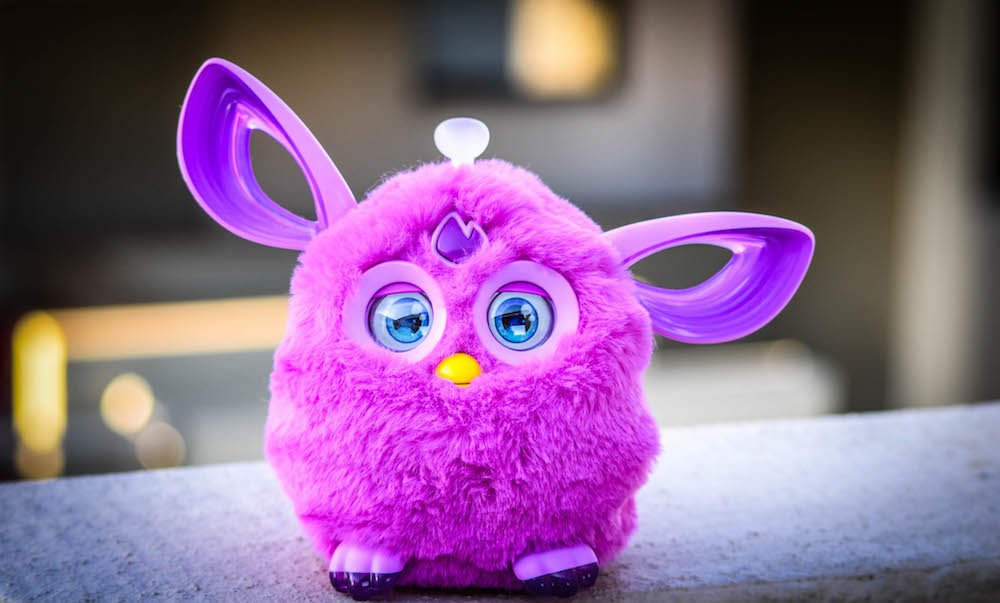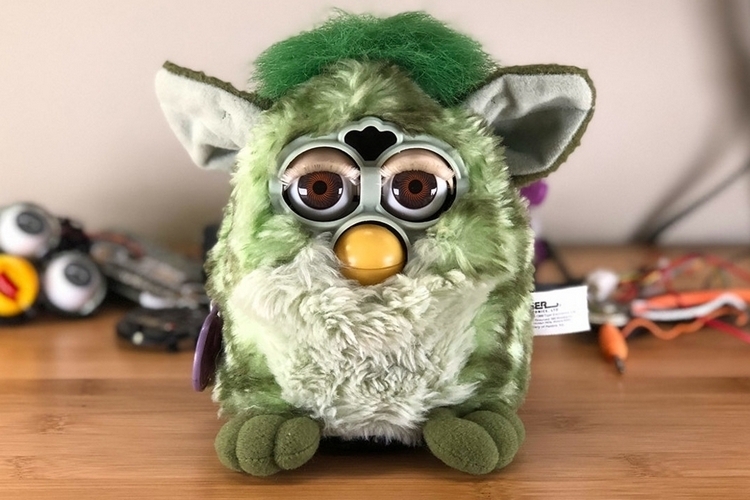
History Of Furby, The Ultimate Electronic Pet

Furby, every 90’s child favorite robotic toy. Whether it was a hamster or an owl we still don’t know, but what we do know is that Furbies sold about 50 million toys worldwide! What makes the Furby an incredibly cute gift is its special language, “Furbysh”, it’s a very simple language made up of a dash of short words and a tad of gibberish, but don’t worry the older they get, the richer their vocabulary becomes.
So, u-nye-loo-lay-doo? (meaning do you want to play? in Furbish of course).
The Brains Behind the Machine
The last quarter of 1998 saw the arrival of a product that completely revolutionized the kid’s toy market and very quickly became the must-have toy for kids around the world. Furby was the product of three ingenious minds; David Hampton, Richard C. Levy and Caleb Chung who created the electronic pet two decades ago to kick-start their journey into the toy industry with a bang, a journey that might not be over yet because 2016 saw a relaunch of the iconic toy.
It is really a tale of how three creative brains came together to create the ultimate in kid’s fun; David Hampton had spent much of his childhood taking apart children’s toys and electronics and then putting back together and would even fix his neighbours’ electronics if they were broken. The electronics and mechanics of internal components fascinated him to the point that by the time he was 13 years of age, he was working at a television repair shop and later even built a ham radio.
Having graduated high school in 1970, Hampton signed up in the Navy to study aviation electronics which saw him travel to numerous places and pick up several languages including Hebrew, Mandarin, Japanese and Thai. By the time his service was over, David had impressed enough people to get several job offers in Silicon Valley, one of which interestingly was a toy development company where a certain Caleb Chung had been working building toys.
In contrast, Caleb Chung did not have a formal educational background in electronics. Having graduated high school, his family moved around several times during his upbringing due to financial insecurity, which in his words, opened his mind to creative possibilities outside the realm of conventional thinking and enabled him to think outside the box. Chung and Hampton had an instant chemistry due to their love for electronics and it’s unsurprising that the two came together to create one of the most iconic toys in history.

Furby was actually inspired by an early 1990’s electronic toy; The Tamagotchi which was on display at the annual Toy Fair trade show in New York
Inspired by Greatness
Furby was actually inspired by an early 1990’s electronic toy; The Tamagotchi which was on display at the annual Toy Fair trade show in New York where David and Chung got their first hands-on experience of the toy. While both of them agreed that the idea was extremely cool, David thought that the toy had one shortcoming, you could not pet the Tamagotchi. This experience got the pair’s creative juices flowing and they decided to design their own toy that you could actually pet; the “Furball” as it was known, spoke a mishmash of languages like Mandarin, Japanese and thai, languages that Hampton had picked up in the Navy.
The Third Musketeer
It was during the licensing of the concept that the third musketeer, Richard C. Levy makes an entry into the story. Having graduated from Boston’s Emerson College with a degree in Television and Cinematography, he spent his early years in film promotions before setting up his own film and documentary production company and later took on an executive role in the WORLDNET satellite company.
Having had experience in the creative industry and marketing, Levy was the perfect candidate to bring Furby to life, and that’s exactly what he did. He was able to ink a deal with Tiger Electronics in 1997 for the development and production of the toy and the acquisition of Tiger Electronics by Hasbro not soon after meant that the trio now had more than enough resources and funding to finally begin development and production of Furby which made it’s official debut at the FAO Schwarz toy store in New York.

It was in 2016 that Furby finally came back with a Bang; the Furby Connect was an ingenious chapter in the journey of the toy’s success and the latest model was app compatible with unlimited ways to interact with your pet toy
An Instant Success
To say that Furby was an incredible success with the younger crowd would be an understatement; having been put up for sale in only one store in New York, the company had more than 35,000 orders by the end of the week and Furby went on to sell 1.8 million units that particular year before skyrocketing to fame in 1999 which saw the sales jump to 14 million units. Furby sold more than 40 million units in it’s product cycle and even though it was updated and re-introduced in 2005, 2007 and 2012, the relaunches were very poor in comparison to early years.
It was in 2016 that Furby finally came back with a Bang; the Furby Connect was an ingenious chapter in the journey of the toy’s success and the latest model was app compatible with unlimited ways to interact with your pet toy. It now gives the ultimate experience of a virtual world with your own pet toy with unlimited interactive options and you can even hatch new Furblings to build your own imaginary Furby village! Seriously, where is my Furby?
More in Funhouse
-
Экспресс Дня 22 декабря Ставки И Прогнозы На Футбол Кэф Дня%3A 4 29
«барселона» «атлетико»%3A Прогноз Карена Адамяна На Матч Ла Лиги 21 Декабря Спорт-экспресс Content «интер» — Единственный Не Пропустил Ни Одного Мяча В Пяти Матчах Лч Но Перед Выездом В Леверкузен Это...
December 28, 2024 -
Polskie Kasyno Online Blik 2024, Najlepsze Maszyny On The Internet Blik
Kasyna Online Blik 2024 Najlepsze Kasyna Z Blik Content Kasyno Online Em Kryptowaluty Czy Blik Obsługuje Wypłaty On The Web? Użyteczność...
December 28, 2024 -
As Melhores Caça-níqueis E Apostas Esportivas Por Dinheiro Real
Jogue Por Recurso Financeiro Real Em Cassino Online Content Pin Upwards Casino: ¡obtén Este Bono De Bienvenida Y Jugar Casino Online!...
December 28, 2024 -
1win официального Сайт Букмекерской Конторы%3A Вход На Зеркало Бк 1вин”
1win Казино И Беттинг 500% Бонус На обналичил Content важнейшие Азартные Игры Информация о Официальном Сайте 1win Casino Ин – Букмекерская...
December 28, 2024 -
Glory Casino Online ️ Play On Official Internet Site In Bangladesh
“Glory Casino Online ⭐️ Play Now On Official Web Site In Bangladesh Glory Casino Online ⭐️ Play Now About Official Web...
December 28, 2024 -
“ruleta Aleatoria » Selectivo Personalizado Para Elecciones Al Azar
Simulador De Ruleta Gratis En Línea Content Variantes De Ruleta Juegos De Ruleta En Color ¿cuál Ha Sido La Diferencia No...
December 28, 2024 -
1xbet Вход а Официальный Сайт прошло Рабочее Зеркало
Казино Онлайн 1xbet Играть Онлайн а Казино ᐉ 1xbet Com Content 💰как Можно Заработать киромарусом 1xbet%3F Прогнозы в Спортивные События Проблемы...
December 28, 2024 -
1win Ödeme Yöntemleri Bahis Hesabınıza Para Yatırmak Için Para Yatırma Seçenekleri
1win Spor Bahisleri Empieza Online Casino Bonus 500% Content Perfect Money Ile 1win Nasıl Afin De Yatırılır Ekspres Bonus Ek Hizmetler...
December 28, 2024 -
Başarıbet: Türkiyede Sobre İyi Casino Ve Bahis Deneyimi
Leon Bet: Güvenilir On-line Bahis Ve Gambling Establishment Deneyimi Content Meybet Canlı Destek Basaribet Casino’da Ödeme İşlemleri Casino Flag Up Türkiye...
December 28, 2024

You must be logged in to post a comment Login